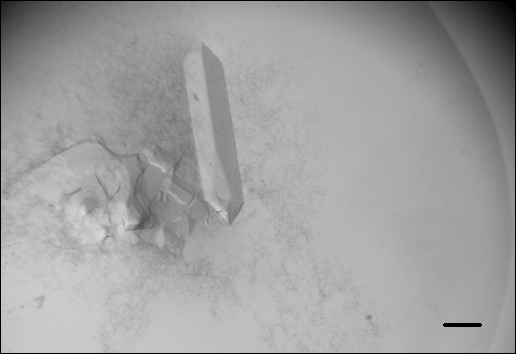Crystallization methods
The production of crystals of high diffraction quality is a prerequisite to obtaining high-resolution structures of proteins and other biological macromolecules. Crystallisation is a complex, multi-parametric process which is poorly understood and controlled. In the laboratory we are developing novel methodology as well as striving for a better understanding of macromolecular crystallogenesis.
- Research into substances and materials promoting the heterogeneous nucleation of crystals is a blossoming topic in crystallogenesis. We have participated in developing the use of materials containing pores or cavities, such as Bioglass, carbon nanotubes, and Molecularly Imprinted Polymers (MIPs), as heterogeneous nucleants, in collaboration with the Group of Prof. Naomi Chayen, Imperial College London, and are pursuing the theoretical understanding of the effect on such materials on the nucleation process.1-8.

- As coordinators of the Industry-Academia Partnerships and Pathways (Marie Curie) Project TOPCRYST, we developed the use of Dual Polarization Interferometry, pioneered by Farfield Scientific Ltd., to probe crystallisation at its most crucial stages. This allows to predict the outcome of crystallization trials when they are still at their earliest stages and thus to rationally design and direct such experiments.9
- The use of Genetic Algorithms10 and of calorimetry11 are additional techniques that we have developed with a view to better crystal optimisation trials design and prediction of crystallisation conditions, respectively. More recently, we have developed methodology designed to produce crystals suitable for serial time-resolved crystallography/ XFEL studies,12 as well as methodology for investigating the role of ions of the Hofmeister Series in protein crystallization.13
Related references
- Carbon-nanotube based materials for protein crystallization. P. Asanithi, E. Saridakis, L. Govada, I. Jurewicz, E. W. Brunner, R. Ponnusamy, J.A.S. Cleaver, A.B. Dalton, N.E. Chayen, R.P. Sear, ACS Appl. Mat. Interf. 2009, 1, 1203-1210.
- Protein crystallization facilitated by molecularly imprinted polymers. E. Saridakis, S. Khurshid, L. Govada, Q. Phan, D. Hawkins, G.V. Crichlow, E. Lolis, S.M. Reddy, N.E. Chayen, Proc. Natl. Acad. Sci. USA 2011, 108, 11081-11086.
- Imprinted polymers assisting protein crystallization. E. Saridakis, N. E. Chayen, Trends Biotech. 2013, 31, 515-520.
- Porous nucleating agents for protein crystallization. S. Khurshid, E. Saridakis, L. Govada and N.E. Chayen, Nat. Protoc. 2014, 9, 1621-1633.
- Protein crystal nucleation in pores. C. N. Nanev, E. Saridakis, N. E. Chayen, Scientific Reports 2017, 7: 35821.
- Hydrophobic interface-assisted protein crystallization: theory and experiment C. N. Nanev, E. Saridakis, L. Govada, S. C. Kassen, H. V. Solomon, N. E. Chayen, ACS Appl. Mat. Interf. 2019, 11, 12931-12940. doi: 10.1021/acsami.8b20995.
- Graphene-based nucleants for protein crystallisation. L. Govada, N. Rubio, E. Saridakis, K. Balaskandan, Y. Li, B. Wang, M. Shaffer, N. Chayen. Adv. Funct. Mater. 2022,32,2202596.
- Protein crystals nucleated and grown by means of porous materials display improved X-ray diffraction quality. C.N. Nanev, E. Saridakis, L. Govada and N.E. Chayen. Int. J. Mol. Sci. 2022,23,10676.
- Use of Dual Polarisation Interferometry as a diagnostic tool for protein crystallization. A. Boudjemline, E. Saridakis, M. J. Swann, L. Govada, I. M. Mavridis, N. E. Chayen, Anal. Chem. 2011, 83, 7881-7887.
- A novel Genetic Algorithm-inspired concept for macromolecular crystal optimisation. E. Saridakis. Crystal Growth Des. 2011, 11, 2993-2998.
- Influence of precipitating agents on thermodynamic parameters of protein crystallization solutions. P. Stavros, E. Saridakis, G. Nounesis. Biopolymers 2016, 105, 642-652.
- Growing crystals for X-ray Free-Electron Laser structural studies of biomolecules and their complexes. C.N. Nanev, E. Saridakis, N.E. Chayen. Int. J. Mol. Sci. 2023, 24, 16336.
- Protein thermodynamic properties, crystallisation, and the Hofmeister Series. E. Saridakis, K. Donta. ChemPlusChem 2024, 89, e202300733.